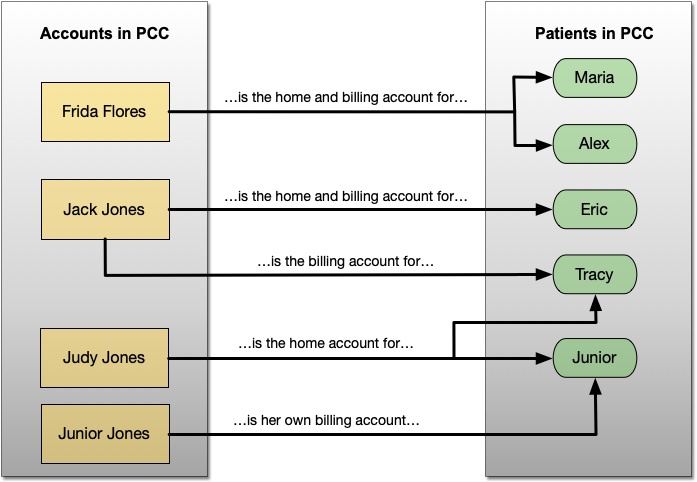Patient and Family Accounts in PCC Explained
Your PCC system keeps track of families and patients. Your practice’s database stores information about every patient, with a patient chart for each one. PCC also stores a database of accounts, or “families.” An account may be either a “Home” account for the patient or a “Billing” account. These are sometimes called the custodian and guarantor accounts.
Three siblings may all have one family account serving as both home and billing account. The whole family may be listed under a single parent’s name and address. Alternatively, a patient may have one family account assigned as the Home account and a different account assigned for Billing.
It may be helpful to think of your PCC system as holding two giant lists: a list of patients and a list of accounts. Patients are linked-up to one or more family accounts, and they can be moved around to different accounts when families change shape. You schedule an appointment for a patient, you chart a visit for a patient, but you mail a bill to the billing account for that patient, and you might send a Flu Clinic flyer to the Home account of that patient.
In the image below, a list of accounts is on the left-hand side, and a list of patients is on the right-hand side. You can see how PCC family accounts and patients can be linked together to handle different kinds of families.

As shown above, some patients live with one account but have their bills sent to another family. Tracy Jones lives with her mother Judy, but Jack Jones pays Tracy’s medical bills. Junior Jones also lives with Judy, but he is responsible for his own bills and is therefore his own Billing account. Your practice can handle all of these situations with ease using PCC.
Multiple Names in EHR Accounts: PCC recommends your practice avoid using two names in an account, such as “Jack & Jill Smith” and instead select a single person as a home and/or billing account. Additional parents or guardians, that are neither home nor billing account, should be added as Personal Contacts and given their own Patient Portal account linked to the patient.
